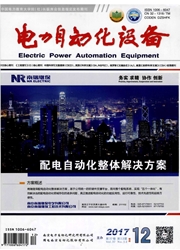

 中文摘要:
中文摘要:
大规模可再生新能源并网增加了网络节点功率流向的不确定性,使节点的源、荷特性不再清晰,给广义负荷建模带来了新的挑战。因此提出一种基于仿射传播(AP)聚类算法的广义负荷稳态特性聚类方法。对广义负荷节点根母线功率数据进行特征分析,利用动力学的波动强度理论选取功率波动序列的最小时间长度。以时段内各最小时间长度的样本波动强度序列以及时段内样本数据数字特征为指标构造日时段特征向量,并以该特征向量为聚类指标,应用AP聚类算法自适应调整建模数据的聚类数和聚类中心。通过引入概率信息的广义负荷建模方法对各聚类类别样本建模并检验聚类方法的有效性。算例分析表明,该聚类方法自适应确定聚类类别且聚类效果好,能够充分反映日时段特性,聚类后通过特性综合得到精确广义负荷模型,应用于风电接入后的风险分析仿真计算。
 英文摘要:
英文摘要:
Since the grid-connection of large-scale renewable energy increases the uncertainty of nodal power flow,the source and load characteristics of node become unclear,which brings new challenges to the generalized load modeling. A method based on AP(Affinity Propagation) clustering algorithm is proposed for the generalized load steady-state characteristics clustering. The characteristic analysis is carried out for the root bus power data of generalized load node and the minimum time period of power fluctuation sequence is determined based on the fluctuation intensity theory of dynamics. The daily periodic feature vector is formed by the fluctuation intensity sequence of sample with the minimum time length in each period and the digital feature index of sample data within the period,with which as the clustering index,the AP clustering algorithm is applied to adaptively adjust the cluster number and center. The probabilistic information is introduced to the generalized load modeling method,which is then used to build the model for different clusters and verify the accuracy of clustering algorithm. Simulative analysis shows that,the clustering algorithm adaptively determines the clusters to fully reflect the daily periodic features,and an accurate generalized load model is obtained by the characteristic synthesis,which is applied to the simulative analysis of wind-power integration risk.
 同期刊论文项目
同期刊论文项目
 同项目期刊论文
同项目期刊论文
 Calculation of Power Transfer Limit Considering Electro-Thermal Coupling of Overhead Transmission Li
Calculation of Power Transfer Limit Considering Electro-Thermal Coupling of Overhead Transmission Li 期刊信息
期刊信息
